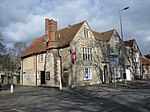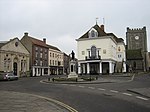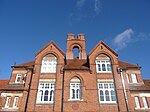Wallingford Priory
1097 establishments in England1525 disestablishments in EnglandBenedictine monasteries in EnglandChristian monasteries established in the 11th centuryMonasteries in Berkshire ... and 2 more
Monasteries in OxfordshireWallingford, Oxfordshire
Wallingford Priory was a Benedictine priory dedicated to the Holy Trinity in Wallingford in the English county of Berkshire (now Oxfordshire). Nothing remains of Holy Trinity Priory, which is believed to have stood on the site of the Bullcroft recreation ground off the High Street.
Excerpt from the Wikipedia article Wallingford Priory (License: CC BY-SA 3.0, Authors).Wallingford Priory
High Street, South Oxfordshire Winterbrook
Geographical coordinates (GPS) Address Nearby Places Show on map
Geographical coordinates (GPS)
| Latitude | Longitude |
|---|---|
| N 51.60127 ° | E -1.1267 ° |
Address
High Street
High Street
OX10 0EF South Oxfordshire, Winterbrook
England, United Kingdom
Open on Google Maps









